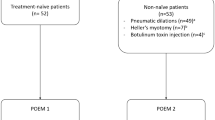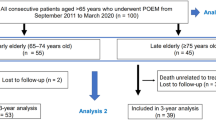Abstract
Background
Peroral endoscopic myotomy (POEM) is a safe and effective approach for achalasia. However, the safety, feasibility, perioperative and long-term efficacy in treating geriatric patients has not been well evaluated.
Methods
Data of 2367 patients diagnosed with achalasia and treated with POEM in the Endoscopy Center, Zhongshan Hospital, Fudan University from August 2010 to December 2017 were retrospectively reviewed. Last follow-up was in December 2018. Propensity score matching based on baseline characteristics was used to adjust for confounding. With a caliper of 0.01 in propensity scoring, 139 patients aged ≥ 65 years were matched at a 1:2 ratio with 275 patients aged < 65 years. Perioperative complications and long-term outcomes were compared between the two groups.
Results
After propensity score matching, the two groups had similar baseline clinical characteristics and distribution of propensity scores. The mean age was 70.22 years in geriatric patients and 42.02 in younger patients. Technical failure occurred in one geriatric and one non-geriatric patients (p = 0.485). The procedural time in geriatric patients was similar to younger patients [50 (interquartile range (IQR) 36–76) vs. 50 (IQR 36–70) min, p = 0.398]. There were also no significant differences in major perioperative adverse events (2.88% vs. 2.18%, p = 0.663) and hospitalization length (median 3 vs. 3 days, p = 0.488). During a median follow-up period of 41 months (IQR 26–60), mean decrease in Eckardt score and pressure of the LES were 6.63 and 11.9 mmHg in geriatric patients, which were similar to the change in non-geriatric patients (6.49 and 11.6 mmHg, p = 0.652 and 0.872, respectively). Clinical reflux occurred in 23.53% geriatric patients and 21.59% non-geriatric patients (p = 0.724). 5-year success rate of 92.94% was achieved in geriatric patients and 92.61% in younger patients (log-rank p = 0.737).
Conclusions
POEM is a safe and reliable treatment in geriatric achalasia patients with confirmed short-term and long-term efficacy compared with those in non-geriatric patients.


Similar content being viewed by others
References
Richter JE (2010) Achalasia—an update. J Neurogastroenterol Motil 16:232–242
Boeckxstaens GE, Zaninotto G, Richter JE (2014) Achalasia. Lancet (London, England) 383:83–93
Sonnenberg A (2009) Hospitalization for achalasia in the United States 1997–2006. Dig Dis Sci 54:1680–1685
Gennaro N, Portale G, Gallo C et al (2011) Esophageal achalasia in the Veneto region: epidemiology and treatment Epidemiology and treatment of achalasia. J Gastrointest Surg 15:423–428
Rubin DB (2004) On principles for modeling propensity scores in medical research. Pharmacoepidemiol Drug Saf 13:855–857
Inoue H, Minami H, Kobayashi Y et al (2010) Peroral endoscopic myotomy (POEM) for esophageal achalasia. Endoscopy 42:265–271
Ren Y, Tang X, Chen Y et al (2017) Pre-treatment Eckardt score is a simple factor for predicting one-year peroral endoscopic myotomy failure in patients with achalasia. Surg Endosc 31:3234–3241
Wu QN, Xu XY, Zhang XC et al (2017) Submucosal fibrosis in achalasia patients is a rare cause of aborted peroral endoscopic myotomy procedures. Endoscopy 49:736–744
Zhang XC, Li QL, Xu MD et al (2016) Major perioperative adverse events of peroral endoscopic myotomy: a systematic 5-year analysis. Endoscopy 48:967–978
Li QL, Wu QN, Zhang XC et al (2018) Outcomes of per-oral endoscopic myotomy for treatment of esophageal achalasia with a median follow-up of 49 months. Gastrointest Endosc 87(1405–1412):e1403
Jones R, Junghard O, Dent J et al (2009) Development of the GerdQ, a tool for the diagnosis and management of gastro-oesophageal reflux disease in primary care. Aliment Pharmacol Ther 30:1030–1038
Li CJ, Tan YY, Wang XH et al (2015) Peroral endoscopic myotomy for achalasia in patients aged >/= 65 years. World J Gastroenterol 21:9175–9181
Wang X, Tan Y, Lv L et al (2016) Peroral endoscopic myotomy versus pneumatic dilation for achalasia in patients aged >/= 65 years. Rev Esp Enferm Digest 108:637–641
Tang X, Ren Y, Gao Q et al (2017) Peroral endoscopic myotomy is safe and effective in achalasia patients aged older than 60 years compared with younger patients. Geriatr Gerontol Int 17:2407–2413
Hernandez-Mondragon OV, Solorzano-Pineda OM, Blancas-Valencia JM et al (2017) Per-oral Endoscopic Myotomy (POEM): a safe and effective treatment for achalasia in geriatric patients. Rev Med del Inst Mex del Seguro Soc 55:S376–s382
Rakita S, Bloomston M, Villadolid D et al (2005) Age affects presenting symptoms of achalasia and outcomes after myotomy. Am Surg 71:424–429
Funding
This study was supported by the Grants from the National Natural Science Foundation of China (Grant Nos. 81873552, 81570595, and 81670483), Major Project of Shanghai Municipal Science and Technology Committee (Grant Nos. 18ZR1406700, 16411950400), Shanghai Sailing Program of Shanghai Municipal Science and Technology Committee (Grant No. 2018YF1403700), Outstanding Young Doctor Training Project of Shanghai Municipal Commission of Health and Family Planning (Grant No. 2017YQ026), Chen Guang Program of Shanghai Municipal Education Commission (Grant No. 15CG04), and the Project of Shanghai Municipal Commission of Health and Family Planning (Grant No. SHDC12016203).
Author information
Authors and Affiliations
Contributions
Q-LL, P-HZ: Planning and conducting the study. P-HZ, M-DX, S-YC, Y-SZ, Y-QZ, W-FC, Q-LL, L-QY, X-YL, JC, Z-QL, YW, W-ZQ, J-WH, M-YC: Collecting data. X-YL, Q-LL, JC, W-FC: Analyzing and interpreting data. X-YL, Q-LL: Drafting manuscript. All authors: Final approval of manuscript: .
Corresponding authors
Ethics declarations
Disclosure
Drs. Xin-Yang Liu, Jing Cheng, Wei-Feng Chen, Mei-Dong Xu, Zu-Qiang Liu, Yun-Wang, Shi-Yao Chen, Yun-Shi Zhong, Yi-Qun Zhang, Wen-Zheng Qin, Jian-Wei Hu, Ming-Yan Cai, Li-Qing Yao, Quan-Lin Li and Ping-Hong Zhou have no conflicts of interest or financial ties to disclose.
Additional information
Publisher's Note
Springer Nature remains neutral with regard to jurisdictional claims in published maps and institutional affiliations.
Impact statement
We certify that this work is novel. We systematically analyzed the largest real-world database of long-term outcomes of POEM for the treatment of achalasia in geriatric patients compared with non-geriatric patients. POEM is a safe and reliable treatment in geriatric achalasia patients with confirmed short-term and long-term efficacy compared with those in non-geriatric patients.
Electronic supplementary material
Below is the link to the electronic supplementary material.
Rights and permissions
About this article
Cite this article
Liu, XY., Cheng, J., Chen, WF. et al. Effect of peroral endoscopic myotomy in geriatric patients: a propensity score matching study. Surg Endosc 34, 2911–2917 (2020). https://doi.org/10.1007/s00464-019-07070-9
Received:
Accepted:
Published:
Issue Date:
DOI: https://doi.org/10.1007/s00464-019-07070-9




